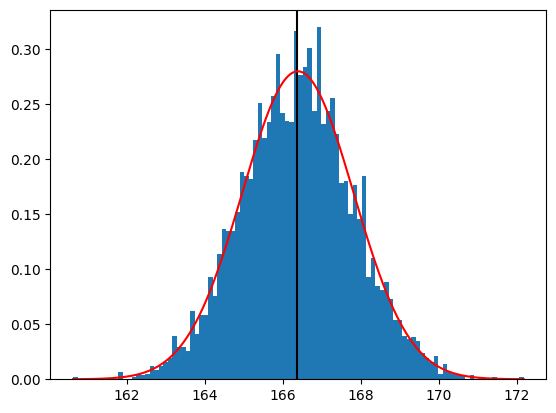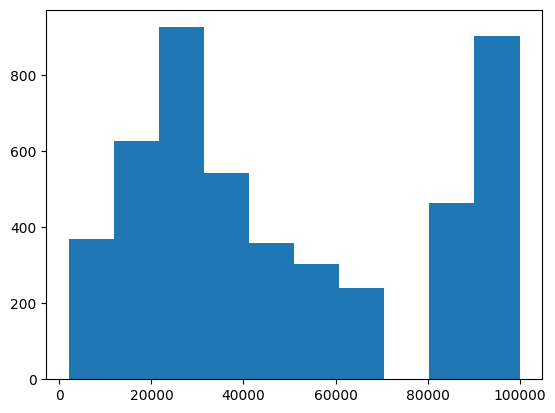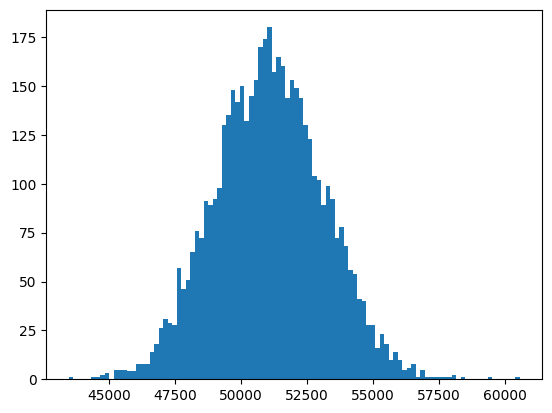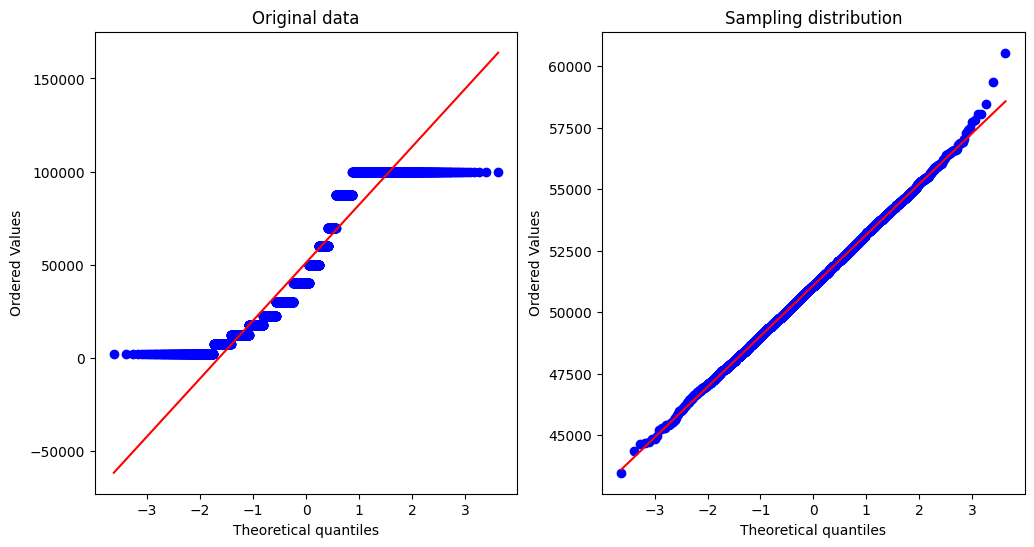Sampling#
In this chapter we will learn how to use Python to understand sampling and sampling error.
Sampling error#
Here we will repeatedly sample from the NHANES Height variable in order to obtain the sampling distribution of the mean. First let’s load the data and clean them up.
! pip install nhanes
from nhanes.load import load_NHANES_data
nhanes_data = load_NHANES_data()
adult_nhanes_data = nhanes_data.query('AgeInYearsAtScreening > 17')
adult_nhanes_data = adult_nhanes_data.dropna(subset=['StandingHeightCm']).rename(columns={'StandingHeightCm': 'Height'})
Requirement already satisfied: nhanes in /miniconda/lib/python3.12/site-packages (0.5.1)
WARNING: Running pip as the 'root' user can result in broken permissions and conflicting behaviour with the system package manager. It is recommended to use a virtual environment instead: https://pip.pypa.io/warnings/venv
Now let’s draw a sample of 50 individuals from the dataset, and calculate its mean. Try to execude the next cell repeatedly. What do you see?
sample_size = 50
sample = adult_nhanes_data.sample(sample_size)
print('Sample mean:', sample['Height'].mean())
print('Sample standard deviation:', sample['Height'].std())
Sample mean: 166.674
Sample standard deviation: 9.332515245973429
Now let’s repeatedly sample 50 individuals from the dataset, compute the mean, and store the resulting values. For this we are going to use a for loop, which allows us to repeatedly perform a particular set of actions.
#+
sample_size = 50
num_samples = 5000
import pandas as pd
import numpy as np
# set up a variable to store the result
sampling_results = pd.DataFrame({'mean': np.zeros(num_samples)})
print('An empty data frame to be filled with sampling means:')
print(sampling_results)
for sample_num in range(num_samples):
sample = adult_nhanes_data.sample(sample_size)
sampling_results.loc[sample_num, 'mean'] = sample['Height'].mean()
#-
print('Means of 5000 samples:')
print(sampling_results)
An empty data frame to be filled with sampling means:
mean
0 0.0
1 0.0
2 0.0
3 0.0
4 0.0
... ...
4995 0.0
4996 0.0
4997 0.0
4998 0.0
4999 0.0
[5000 rows x 1 columns]
Means of 5000 samples:
mean
0 164.440
1 166.154
2 166.076
3 167.790
4 166.320
... ...
4995 164.608
4996 165.752
4997 165.846
4998 166.056
4999 167.320
[5000 rows x 1 columns]
Now let’s plot the sampling distribution. We will also overlay the sampling distribution of the mean predicted on the basis of the population mean and standard deviation, to show that it properly describes the actual sampling distribution. We also place a vertical line at the population mean.
#+
import matplotlib.pyplot as plt
import numpy as np
import scipy.stats
import seaborn as sns
hist = plt.hist(sampling_results['mean'], 100, density=True)
# hist[0] contains the histogram data
# we need to use the maximum of those data to set
# the height of the vertical line that shows the mean
plt.axvline(x=adult_nhanes_data['Height'].mean(),
ymax=1, color='k')
# draw the normal distribution with same mean and standard deviation
# as the sampling distribution
hist_bin_min = np.min(hist[1])
hist_bin_max = np.max(hist[1])
step_size = 0.01
x_values = np.arange(hist_bin_min, hist_bin_max, step_size)
normal_values = scipy.stats.norm.pdf(
x_values,
loc=sampling_results['mean'].mean(),
scale=sampling_results['mean'].std())
plt.plot(x_values, normal_values, color='r')
#+
print('standard deviation of the sample means:', sampling_results['mean'].std())
standard deviation of the sample means: 1.4263738968936954

Now, can you redo the simulation of sampling above, but make the following changes each time?
Changing the sample size to 5 or 500. What difference do you observe in the distribution of sample means?
Changing the number of times to draw the samples to 50,000. Does the histogram appear closer to a normal distribution?
Central limit theorem#
The central limit theorem tells us that the sampling distribution of the mean becomes normal as the sample size grows. Let’s test this by sampling a clearly non-normal variable and look at the normality of the results using a Q-Q plot. For example, let’s look at the variable that represents annual family income. This variable is oddly distributed:
plt.hist(adult_nhanes_data['AnnualFamilyIncome'])
plt.show()

This odd distribution comes in part from the how the variable is coded, as shown here. Let’s resample this variable 5000 times, compute the mean, and examine the distribution. To do this, we will create a function that resamples and returns the mean:
def sample_and_return_mean(df, variable_name,
sample_size=250, num_samples=5000):
"""
repeatedly take samples from a particular variable in a data frame
and compute the mean
Parameters:
-----------
df: data frame containing the data
variable_name: the name of the variable to be analyzed
sample_size: the number of observations to sample each time
num_samples: the number of samples to take
Returns:
--------
sampling_distribution: data frame containing the means
"""
sampling_distribution = pd.DataFrame({'mean': np.zeros(num_samples)})
for sample_number in range(num_samples):
sample_df = df.sample(sample_size)
sampling_distribution.loc[sample_number, 'mean'] = sample_df[variable_name].mean()
return(sampling_distribution)
Now, using this function, let’s compute the sampling distribution for the annual family income variable and plot its histogram.
adult_income_data = adult_nhanes_data.dropna(subset=['AnnualFamilyIncome'])
family_income_sampling_dist = sample_and_return_mean(adult_income_data, 'AnnualFamilyIncome')
_ = plt.hist(family_income_sampling_dist['mean'], 100)
plt.show()

This distribution looks nearly normal. We can also use a quantile-quantile, or “Q-Q” plot, to examine this.
Quantile means the value below which certain percentage of all the scores are distributed. 5 percentile means 5% of the score is below this value. If two distributions are of the same shape, then their corresponding percentiles should form a linear relationship.
We will plot two Q-Q plots; on the left we plot one for the original data, and on the right we plot one for the sampling distribution of the mean.
plt.figure(figsize=(12, 6))
plt.subplot(1, 2, 1)
scipy.stats.probplot(adult_income_data['AnnualFamilyIncome'], plot=sns.mpl.pyplot)
plt.title('Original data')
plt.subplot(1, 2, 2)
scipy.stats.probplot(family_income_sampling_dist['mean'], plot=sns.mpl.pyplot)
plt.title('Sampling distribution')
Text(0.5, 1.0, 'Sampling distribution')

We see that the raw data are highly non-normal, evidenced by the fact that the data values diverge greatly from the unit line. On the other hand, the sampling distribution looks much more normally distributed.
Confidence intervals#
Remember that confidence intervals are intervals that will contain the population parameter in a certain proportion of samples from the population. In this example we will walk through the simulation that was presented in the book to show that this actually works properly. To do this, let’s create a function that takes a sample from the NHANES population and returns the confidence interval for the mean of the Height variable within that sample. We will use the t distribution to obtain our confidence intervals.
def get_confidence_interval(df, variable_name,
ci_percent=95,
sample_size=50):
sample_df = df.sample(sample_size)
mean = sample_df[variable_name].mean()
std = sample_df[variable_name].std()
sem = std / np.sqrt(sample_size)
t_tail_proportion = 1 - ((100 - ci_percent) / 100) / 2
t_cutoff = scipy.stats.t.ppf(t_tail_proportion, sample_size - 1)
upper_ci = mean + sem * t_cutoff
lower_ci = mean - sem * t_cutoff
return([lower_ci, upper_ci])
Using this function, let’s resample the data 1000 times and look how often the resulting interval contains the population mean.
num_runs = 1000
ci_df = pd.DataFrame({'lower': np.zeros(num_runs),
'upper': np.zeros(num_runs)})
for i in range(num_runs):
ci_df.iloc[i, :] = get_confidence_interval(
adult_nhanes_data,
'Height'
)
Now we need to compute the proportion of confidence intervals that capture the population mean (which we know because we are treating the entire NHANES dataset as our population). Here we will use a trick that relies upon the fact that Python treat True/False identically to one and zero respectively. We will test for each of the confidence limits (upper and lower) whether it captures the population mean, and then we will multiply those two series of values together. This will create a new variable that is True only if both limits capture the population mean. We then simply take the mean of those truth values to compute the poportion of confidence intervals that capture the mean.
ci_df['captures_mean'] = (ci_df['lower'] < adult_nhanes_data['Height'].mean()) * (ci_df['upper'] > adult_nhanes_data['Height'].mean())
ci_df['captures_mean'].mean()
0.953
This number should be very close to 0.95.